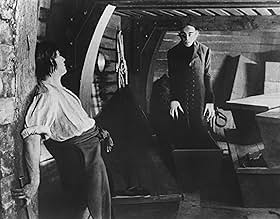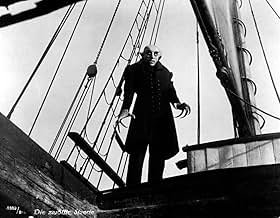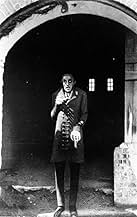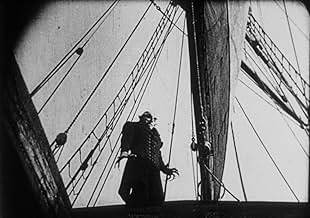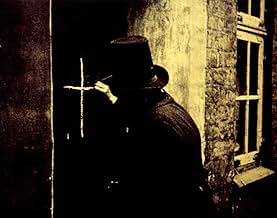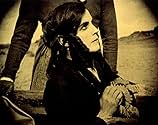Hutter viaja até aos Cárpatos para vender um castelo cujo proprietário é o Conde Orlock, um vampiro que vai para Bremen e espalha o terror. Quem pode reverter esta situação é Ellen, a esposa... Ler tudoHutter viaja até aos Cárpatos para vender um castelo cujo proprietário é o Conde Orlock, um vampiro que vai para Bremen e espalha o terror. Quem pode reverter esta situação é Ellen, a esposa de Hutter, pois Orlock está apaixonado por ela.Hutter viaja até aos Cárpatos para vender um castelo cujo proprietário é o Conde Orlock, um vampiro que vai para Bremen e espalha o terror. Quem pode reverter esta situação é Ellen, a esposa de Hutter, pois Orlock está apaixonado por ela.
- Direção
- Roteiristas
- Artistas
- Prêmios
- 3 vitórias e 2 indicações no total
Gustav von Wangenheim
- Hutter
- (as Gustav v. Wangenheim)
Greta Schröder
- Ellen - seine Frau
- (as Greta Schroeder)
Georg H. Schnell
- Harding - ein Reeder
- (as G.H. Schnell)
Karl Etlinger
- Kontrolleur am Kai
- (não creditado)
Hans Lanser-Ludolff
- A magistrate
- (não creditado)
Loni Nest
- Child at Window
- (não creditado)
Fritz Rasp
- Knocks Mitarbeiter
- (não creditado)
Josef Sareny
- Head Coachman
- (não creditado)
Fanny Schreck
- Krankenschwester im Hospital
- (não creditado)
Eric van Viele
- Matrose 2
- (não creditado)
- Direção
- Roteiristas
- Elenco e equipe completos
- Produção, bilheteria e muito mais no IMDbPro
Avaliações em destaque
F.W. Murnau set the bar high for vampire movies, very high. Can not help but start praising the job Max Schreck and Murnau did to bring Count Orlok character to life on the screen. Orlok's face, hands and slender build along with his sly shuffling movements with the right camera angles and props brought a hell of a lot of general creepiness. The viewers in the twenties must have been shell shocked because they didn't tame it down which they most often did in this time period. For a full length silent feature film I found the time going fairly fast with a view dragged out scenes, that can be expected. The big bugaboo I have with Nosferatu though is the questionable ending being terribly anticlimactic. Regardless of the disappointing ending, Nosferatu is a killer film that is a must watch for horror or classic movie fans.
I despise most vampire stories. Not even Florence Stoker's dear departed husband could keep me occupied after the first act in Transylvania in "Dracula". The vampire has been so romanticized as an archetype (particularly during the '90s) that I can't but feel that most horror fans have forgotten exactly what made us afraid of these guys to begin with. Murnau's "Nosferatu" is just such a reminder and, because of that, is the only screen version of "Dracula" that I have ever loved.
Though Murnau, in the hopes of dodging the copyright bullet, took many liberties with the novel, he actually shot a great part of the film on location (an unusual practice for the time) in the historical Dracula's old stomping grounds: the Carpathian Mountains in Romania. The town, landscapes, and castles were all for real, not just some fancy studio backdrop. To me, it helps convey the tone of authenticity, as you can believe this story being told. As for Max Schreck, no charming, suave seducer is he. With his bald head, bushy eyebrows, rat-like teeth, pointed ears, nails as long as the fingers they are attached to, emaciated build, and stare that seems to come from the bottom of Hell itself, he is the primal, archetypal image of the vampire of legend.
While some could interpret this tale as a subtext to Nazism or anti-Semetism, at it's core, it's simply the tale of a monster, who brings ruin and death in his wake. That such a tale has managed to survive it's era, considering the obstacles that could have totally removed it from view, is the gain of all who have seen. Eat your heart out, Bela Lugosi.
Though Murnau, in the hopes of dodging the copyright bullet, took many liberties with the novel, he actually shot a great part of the film on location (an unusual practice for the time) in the historical Dracula's old stomping grounds: the Carpathian Mountains in Romania. The town, landscapes, and castles were all for real, not just some fancy studio backdrop. To me, it helps convey the tone of authenticity, as you can believe this story being told. As for Max Schreck, no charming, suave seducer is he. With his bald head, bushy eyebrows, rat-like teeth, pointed ears, nails as long as the fingers they are attached to, emaciated build, and stare that seems to come from the bottom of Hell itself, he is the primal, archetypal image of the vampire of legend.
While some could interpret this tale as a subtext to Nazism or anti-Semetism, at it's core, it's simply the tale of a monster, who brings ruin and death in his wake. That such a tale has managed to survive it's era, considering the obstacles that could have totally removed it from view, is the gain of all who have seen. Eat your heart out, Bela Lugosi.
Nosferatu is a great horror movie (possibly the first ever according to some accounts), and one of the pinnacles of the German silent era of film-making. Made in the silent age by the German expressionist/auteur FW Murnau, the film has the genuine power to act creepy, odd, alluring, mythic, and beautiful by way of images and music that don't leave your mind once the film is over. It's like someone collected a stash of nightmares and pulled them together with the original Bram Stoker story of Dracula. Max Shreck, in his most notorious role (and apparently the only one really anyone's bothered to see) plays the monstrous Count Orlock, a vampire who comes out at night to tempt the living and, of course, to suck blood. Though this story of Dracula has been numerously repeated (even by the Hollywood version in the early 30s), this film is one of the prime examples of how horror SHOULD be done- dispense with cheap thrills or overloading with exposition.
A director like Murnau here, who had total artistic control (abeit the film not in circulation for many years), could transform Orlock's world into one of acute, deliberate angles, long deep shadows, and painting with light like some mad artist from the dark ages. One could almost claim that this, alongside Night of the Living Dead, changed the way audiences looked at horror films, that a style and presence could be wrung from characters that bring out the worst fears and dread in common people. Years from now, long into the digital age, there may still be room for of all things a silent, non-talking effort like Nosferatu, where the terror can still be felt through the black and white (sometimes tinted) photography and stark physical performances by Schrek and the others. In short, a film like this is one of the reasons I love to watch horror movies.
A director like Murnau here, who had total artistic control (abeit the film not in circulation for many years), could transform Orlock's world into one of acute, deliberate angles, long deep shadows, and painting with light like some mad artist from the dark ages. One could almost claim that this, alongside Night of the Living Dead, changed the way audiences looked at horror films, that a style and presence could be wrung from characters that bring out the worst fears and dread in common people. Years from now, long into the digital age, there may still be room for of all things a silent, non-talking effort like Nosferatu, where the terror can still be felt through the black and white (sometimes tinted) photography and stark physical performances by Schrek and the others. In short, a film like this is one of the reasons I love to watch horror movies.
As I'm sure it is the case for many cinema fans, my respect and admiration towards this production widely excels the enjoyment I had while watching it. "Nosferatu" is a milestone from every possible viewpoint and it's one of those very few movies I think everybody should view at least once (although it actually requires repeated viewings
) It is the very first version of Bram Stoker's legendary vampire tale and easily the most copied film in the history of cinema. I'm sure everyone is familiar with the story of young estate agent Jonathan Harker traveling to Transylvania where he acquaintances the eccentric count who feeds on blood and controls the ones he has bitten, but THIS is the original version. Shot by F.W. Murnau (who also made the equally essential titles "Faust" and "Der Januskopf") and made unforgettable by Max Schreck in his performance as the Count. And, even though this film is over 80 years old, Schreck's image is still as nightmarish as it can be. No visual or make-up effect could ever surpass the simple appearance of Max Schreck! The fact that this film is still very powerful therefore almost entirely depends on his unworldly character. "Nosferatu" is beautiful poetry, difficult to watch at times, but very rewarding. The sexual undertones as well as the shock-aspects have surely dated by now, but they're still present, and as I mentioned before they only increase my respect for Murnau and his crew. A definite must see, just make sure you're in the right mood.
I watched the Kartes Video Communications 1984 video cassette version on a 15 inch screen. Titles were in English. Film quality was good. Sound was matched to action. Cropping appeared good, and titles were completely visible. This should give an idea of the technical quality of the release I watched.
Nosferatu is one of the few silent movies with a significant following today. It deserves a following. The film is a suspense piece. Still it is paced nicely so that it feels tense in the right places but never goes long enough without something happening so as to be boring.
Visually Nosferatu forms the precedent for the vampire in movies. The main difference is that Count Nosferatu has more affinity with rat than bat. Aside from this the main stream image of the vampire is based heavily on Nosferatu. This film has been as influential on modern vampire mythology as the novel Dracula. It is based on the novel Dracula. Especially disturbing to me personally are NosferatuÕs twisted hands.
In terms of the filmÕs being silent, this should not put anyone off. The suspense/ horror genre fits well into this medium. I was lucky enough to see a version with music matched to the scenes, but if the copy you are watching has a bad sound track just play some music you like.
I recommend this film to anyone interested in the horror or suspense films. It is a bit of a cult film, but this does not keep it from being actually good.
Nosferatu is one of the few silent movies with a significant following today. It deserves a following. The film is a suspense piece. Still it is paced nicely so that it feels tense in the right places but never goes long enough without something happening so as to be boring.
Visually Nosferatu forms the precedent for the vampire in movies. The main difference is that Count Nosferatu has more affinity with rat than bat. Aside from this the main stream image of the vampire is based heavily on Nosferatu. This film has been as influential on modern vampire mythology as the novel Dracula. It is based on the novel Dracula. Especially disturbing to me personally are NosferatuÕs twisted hands.
In terms of the filmÕs being silent, this should not put anyone off. The suspense/ horror genre fits well into this medium. I was lucky enough to see a version with music matched to the scenes, but if the copy you are watching has a bad sound track just play some music you like.
I recommend this film to anyone interested in the horror or suspense films. It is a bit of a cult film, but this does not keep it from being actually good.
Você sabia?
- CuriosidadesThe movie was banned in Sweden due to excessive horror. The ban was finally lifted in 1972.
- Erros de gravação(at around 30 mins) When Hutter is writing his letter to Ellen in Count Orlok's castle, the paper that he is meant to be writing on is clearly blank throughout the scene.
- Citações
Graf Orlok: Your wife has such a beautiful neck...
- Versões alternativasThere are a confusing number of different surviving prints, restorations and alternate versions of Nosferatu. In the main, there are three 'complete' restorations and two incomplete, partially-restored versions. All five are available on DVD, while the latest two restorations, from 1995 and 2006, are also on Blu-ray. In addition there are countless low-quality public domain DVDs with different lengths, running speeds and soundtracks. All are derived from a single print held by the Museum of Modern Art (MoMA). They usually have replacement American intertitles and are always in black and white; the film was originally color tinted throughout and only meant to be seen that way. This comprehensive article explains all of them simply and clearly: Nosferatu: The Ultimate Blu-ray and DVD Guide.
- Trilhas sonorasJeux d'enfants - Galop
Written by Jack Norworth
[Plays during the croquet scene in the 2006 restoration]
Principais escolhas
Faça login para avaliar e ver a lista de recomendações personalizadas
Detalhes
- Data de lançamento
- País de origem
- Central de atendimento oficial
- Idiomas
- Também conhecido como
- Nosferatu: uma sinfonia de horror
- Locações de filme
- Starhrad Castle, Nezbudská Lúcka, Eslováquia(castle in ruins)
- Empresas de produção
- Consulte mais créditos da empresa na IMDbPro
Bilheteria
- Faturamento bruto mundial
- US$ 48.892
- Tempo de duração
- 1 h 34 min(94 min)
- Mixagem de som
- Proporção
- 1.33 : 1
Contribua para esta página
Sugerir uma alteração ou adicionar conteúdo ausente


